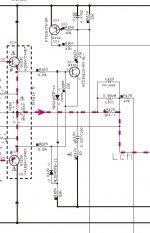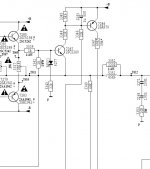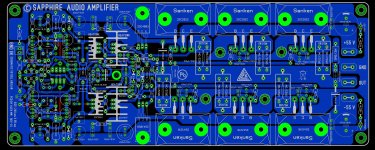" Recent interest in fast Mosfet switches as electromechanical relay replacements is a good case in point for choice."
Yes!
Yes!!
Trench type fets come to good use here due to the extra low Rds-on at Vds saturation.

These are not commercial products, don't have to meet commercial standards and we are quite free to burn down our homes as a result of any shortcomings.
An amplifier without DC offset protection is a potential threat to life and should not be used. An amplifier without SOA protection will die as soon as a momentary short is presented at the output terminals, or a low impedance 'speaker is connected to it. Not good!

Add thermal protection to that! (device de-rating is based on temperature) An amplifier that clips into a speaker is hazardous to the speaker and should be indicated. Overall, fuses are not a bad idea for protection against dead shorts and extreme continuous currents, conditions that may cause combustion.

Add thermal protection to that! (device de-rating is based on temperature) An amplifier that clips into a speaker is hazardous to the speaker and should be indicated. Overall, fuses are not a bad idea for protection against dead shorts and extreme continuous currents, conditions that may cause combustion.
Speaker fuses can reduce the sound quality though, at least getting rid of all 6 of them in my speakers lifted a veil as they say, but there again I also rewired them at the same time so who knows for sure. Perhaps a couple of fuses in the mains transformer secondary would be better for fire hazard protection, protecting speakers and not affecting sound quality so much as directly in series with the speaker.
If an amp blows then a fuse in the speaker line won't save semiconductors hardly at all anyway, only the speaker, and doesn't afford any fire hazard protection against reservoir caps failing.
Fuses in the secondary may be blown when the PS caps initially charge.Speaker fuses can reduce the sound quality though, at least getting rid of all 6 of them in my speakers lifted a veil as they say, but there again I also rewired them at the same time so who knows for sure. Perhaps a couple of fuses in the mains transformer secondary would be better for fire hazard protection, protecting speakers and not affecting sound quality so much as directly in series with the speaker.
If an amp blows then a fuse in the speaker line won't save semiconductors hardly at all anyway, only the speaker, and doesn't afford any fire hazard protection against reservoir caps failing.
Was thinking about rail fuses of course...
Last edited:
Relays and fuses in the signal path add a lot of distortion, especially if they aren't in the feedback loop (which is likely the case with a separate protection circuit).
While is beyond the scope of an average DIY project here, I would welcome a well-thought and transparent protection circuitry in an amp which already possess very good characteristics.
We haven't seen the real world performance nor stability of this amp so maybe it's a little early to put them in the pcb
While is beyond the scope of an average DIY project here, I would welcome a well-thought and transparent protection circuitry in an amp which already possess very good characteristics.
We haven't seen the real world performance nor stability of this amp so maybe it's a little early to put them in the pcb
I appreciate the constraints on commercial products, general domestic and insurance issues etc, but DIYs and professionals design and build plenty of amplifiers with no final destination beyond the workbench in mind. Let's be realistic about what we do here as we're not all manufacturing engineers with safety agendas written in law nor are we obliged to follow ethical codes and remind each other of our public responsibilities. I also think you are overstating the certainty of danger and device failure. There may be strong possibilities of damage or danger but plenty of output stages survive dead shorts as it depends on the signal or DC differential what occurs.An amplifier without DC offset protection is a potential threat to life and should not be used. An amplifier without SOA protection will die as soon as a momentary short is presented at the output terminals, or a low impedance 'speaker is connected to it. Not good!
If it was not clear in my previous post, I'll reiterate that our hobby is dominated by kits and modules that don't include on-board safety features for the reasons of flexibility, choice, compactness and cost. DIYs and pro. developers have followed this path for decades so it is nothing new provided we do include necessary safety features if we progress to a final product in a case with the intention of general use in the home.
I suggest you browse more projects here, go on the net to the various fori, designer websites and designer/supplier sites like ESP.
The most popular source is Ebay shops, but better for your location, would be to drop into Douglas Self's The Signal Transfer Company site and take a look at what's on the amp module boards Gareth Connor and He offer there. Apart from rail fuses?....there's only VI limiter options and they will be used by how many builders?
However, a separate, comprehensive protection card is offered below the Blameless and Load-Invariant modules and that is how most of us, who are too lazy to work a project through from the ground up, usually build amplifiers for our own domestic or general use.
We take our lead from the best. I rest my case
Last edited:
A close rated mains fuse will rupture if you overload the amplifier for more than about 1/10 of a second...........Perhaps a couple of fuses in the mains transformer secondary would be better for fire hazard protection, protecting speakers and not affecting sound quality so much as directly in series with the speaker.
If an amp blows then a fuse in the speaker line won't save semiconductors hardly at all anyway, only the speaker, and doesn't afford any fire hazard protection against reservoir caps failing.
Fit normal transformer mains fusing and that 1/10 second can become minutes until the fuse ruptures.
Normal transformer fuse rating = VA / Vac * 3
Close rated fuse rating <= VA / Vac
That factor of 3 makes a VERY BIG difference to the safety that fusing can bring to the equation.
I also think you are overstating the certainty of danger and device failure. There may be strong possibilities of damage or danger but plenty of output stages survive dead shorts as it depends on the signal or DC differential what occurs.
No; on all counts. Send me mail and I'll send you article on SOA protection.
Last edited:
Thanks for the offer but I don't have need of SOA limiters (if that's what you refer to) in domestic amplifiers. Perhaps I should say that I couldn't sell hi-fi amplifiers if I declared that they were fitted with any type of them. I would agree that PA and instrument amps such as I have also built in small numbers, do need limiters because the average output levels, operating stresses, abuse and risks are relatively much greater. I've been fitting dual and multislope SOA protection to these amps for quite some years because I have seen the damage caused by failures in them and the frequency with which it occurs. If your paper discusses something non-invasive and radically different in operating mode to dual or multislope limiters, I would be grateful to see it.
SOA limiters are very often designed to limit for continuous or near DC dissipations.
This DC limiting does not take advantage of the transient power that all power semiconductors have.
To use this transient capability, the transient limiting must be higher than the DC limiting.
Very few SOA limiters that I have seen use any form of increase in the transient pass capability.
As a result of that enhanced transient pass capability, many amplifiers with properly designed SOA limiting based on continuous power ratings will current limit on transient peaks. Those types of SOA limiters are very likely to be audible when the amplifier is well within it's power ratings.
The transient peaks of all valid audio signals must pass to all valid audio loads for the limiting to be non triggered and thus inaudible.
If the SOA limiter is triggered when a valid audio signal is passed to a valid audio load then the limiter has FAILED to meet the most basic requirement.
This DC limiting does not take advantage of the transient power that all power semiconductors have.
To use this transient capability, the transient limiting must be higher than the DC limiting.
Very few SOA limiters that I have seen use any form of increase in the transient pass capability.
As a result of that enhanced transient pass capability, many amplifiers with properly designed SOA limiting based on continuous power ratings will current limit on transient peaks. Those types of SOA limiters are very likely to be audible when the amplifier is well within it's power ratings.
The transient peaks of all valid audio signals must pass to all valid audio loads for the limiting to be non triggered and thus inaudible.
If the SOA limiter is triggered when a valid audio signal is passed to a valid audio load then the limiter has FAILED to meet the most basic requirement.
Hi, what's your opinion on this type of protection, its more common than VI limiters in Hifi amps I've dealt with, can also add DC offset protection.
Will need supply circuit to match.
Samples are from Marantz and Yamaha.
Regards
Will need supply circuit to match.
Samples are from Marantz and Yamaha.
Regards
Attachments
Hmm.. They appear to only sense current. It would help to make the operation clearer by having a little more of the schematics that show what the output of those current sense circuits (the collectors of Q140 and 7289 resp.) are connected to. Are they conneced to a protection chip/relay control like uPC 1237 or a MCU?
Hmm.. They appear to only sense current. It would help to make the operation clearer by having a little more of the schematics that show what the output of those current sense circuits (the collectors of Q140 and 7289 resp.) are connected to. Are they conneced to a protection chip/relay control like uPC 1237 or a MCU?
Yes it's connected to protection chip, such as uPC1237, or TA7317. Personally I don't like to use this chip, because now it's not easy to get them.
I have a full function protection, with transistors. It's easy to build well working protection, with low price devices.
Sajti
The updated PCB for it?Hi
protect added
and small updates
Thanks, Sajti. I had seen this on several schematics and seen some of them fail to work properly too, probably because there is an assumption that current alone will be sufficient to define safe operation. Anyway, this short article by Mike Renardson has some interesting thoughts on protection schemes for smaller domestic amplifiers.
The OP design is probably at the power level where more sophisticated schemes are necessary and this means making a proper analysis of the output stage load lines to derive the correct value resistors etc. Unfortunately, it won't be ultra-performance any more with those limiters affecting signal transients, even at moderate output levels.
The OP design is probably at the power level where more sophisticated schemes are necessary and this means making a proper analysis of the output stage load lines to derive the correct value resistors etc. Unfortunately, it won't be ultra-performance any more with those limiters affecting signal transients, even at moderate output levels.
Last edited:
Thanks, Sajti. I had seen this on several schematics and seen some of them fail to work properly too, probably because there is an assumption that current alone will be sufficient to define safe operation
It works quite good, if properly designed. The diode+resistor network can help to make it different then simple current limiter. Simulation is big help to optimize it.
Fast switching relay, and additional switch back delay is necessary for it!
Sajti
- Status
- This old topic is closed. If you want to reopen this topic, contact a moderator using the "Report Post" button.
- Home
- Amplifiers
- Solid State
- ultra performance amp



